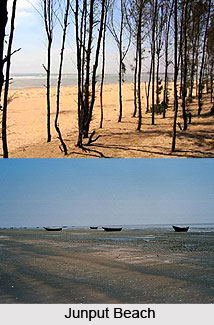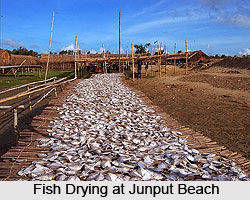 Junput is a beautiful beach resort hugged by casuarina trees located in East Midnapore district of West Bengal. Junput is 40 km away from another beach resort Digha and 9 km from Contai. Junput is mainly used by the State Government Fisheries Department as a study center for marine biology, which includes sea fish research, shark oil extraction and brackish water fish cultivation and research. Unlike Digha beach on the Bay of Bengal, during low-tide Junput becomes very wide and long. Sunrise in Junput is a treat to the eyes of the visitors.
Junput is a beautiful beach resort hugged by casuarina trees located in East Midnapore district of West Bengal. Junput is 40 km away from another beach resort Digha and 9 km from Contai. Junput is mainly used by the State Government Fisheries Department as a study center for marine biology, which includes sea fish research, shark oil extraction and brackish water fish cultivation and research. Unlike Digha beach on the Bay of Bengal, during low-tide Junput becomes very wide and long. Sunrise in Junput is a treat to the eyes of the visitors.
Junput Beach offers a beautiful sea view. The beach is spotted with Casuarina trees. The beach is unspoilt. After independence, Junput was overlooked for development as a beach resort. However in the recent era Junput with its pristine treasure stands out as the tourist`s choice. Junput is very close to Digha and is also a beach resort of Midnapore. The beach is extremely calm and quiet, with gentle breeze brushing across the visitors, to provide for a peaceful and tranquil environment. There is farm for breeding ducks in Junput. Junput has also a centre for a study in oceanic biology and is the base for the area"s sea-fish research and shark oil extraction.
The total area has a huge tourism potential, which still remains unexplored. Since the sea has subsided quite a bit from the land area, the spot provides an excellent opportunity for waders and bird watchers.
Nearby Attractions at Junput Beach
The sea of Junput is very much calm and quiet and the beach is also not very much crowded. Apart from the mesmerising view of sunrise and sunset at the sea beach of Junput, one can also enjoy some other nearby attractions which are present at Junput, which are
•Dariapur Lighthouse: It is situated very near to Junput Beach and is a much visit place. This lighthouse was built during 20th Century and is somewhat 75m high.

•Kapalkundala Mandir: Kapalkundala Temple is a renowned Kali Temple located nearly 500m away from Junput beach. This temple has a close association with the novel written in same name by renowned novelist Bankim Chandra Chattopadhyay.
•Museum: One can also visit the Museum in Junput, which is under the Fishery Department of West Bengal. This museum houses corpses of rare species of fishes, different kinds of snakes and skeletons of different wild animals.
Best Time to Visit Junput
Best time to visit Junput is during the months of October to March. The weather at that time remains very much pleasant there.
How to Reach Junput Beach
Junput is well connected with Digha, and regular bus services are available. Rail connectivity to Junput is through Contai town which is 10 kms away. Bus services are available from Digha which is 40 km from Junput.



















